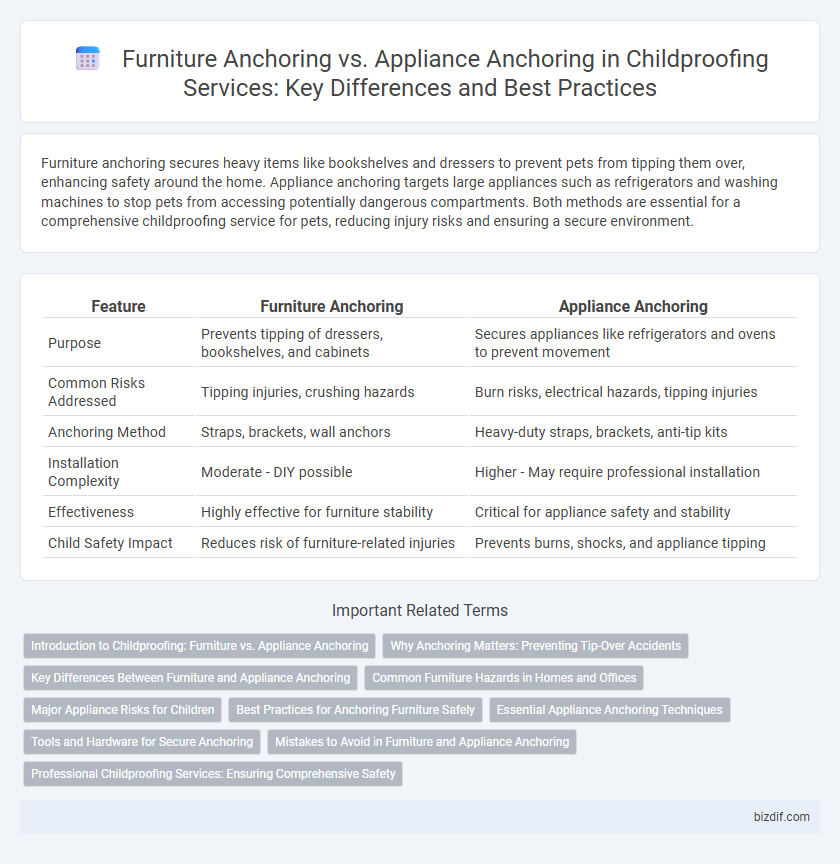Furniture anchoring secures heavy items like bookshelves and dressers to prevent pets from tipping them over, enhancing safety around the home. Appliance anchoring targets large appliances such as refrigerators and washing machines to stop pets from accessing potentially dangerous compartments. Both methods are essential for a comprehensive childproofing service for pets, reducing injury risks and ensuring a secure environment.
Table of Comparison
| Feature | Furniture Anchoring | Appliance Anchoring |
|---|---|---|
| Purpose | Prevents tipping of dressers, bookshelves, and cabinets | Secures appliances like refrigerators and ovens to prevent movement |
| Common Risks Addressed | Tipping injuries, crushing hazards | Burn risks, electrical hazards, tipping injuries |
| Anchoring Method | Straps, brackets, wall anchors | Heavy-duty straps, brackets, anti-tip kits |
| Installation Complexity | Moderate - DIY possible | Higher - May require professional installation |
| Effectiveness | Highly effective for furniture stability | Critical for appliance safety and stability |
| Child Safety Impact | Reduces risk of furniture-related injuries | Prevents burns, shocks, and appliance tipping |
Introduction to Childproofing: Furniture vs. Appliance Anchoring
Furniture anchoring and appliance anchoring are essential childproofing strategies designed to prevent tip-over accidents by securing heavy items to walls or floors. Furniture anchoring typically involves fastening bookshelves, dressers, and cabinets using straps or brackets, reducing the risk of injury from falling objects. Appliance anchoring focuses on securing large appliances like refrigerators, ovens, and washing machines to ensure stability and protect children from hazardous tipping incidents.
Why Anchoring Matters: Preventing Tip-Over Accidents
Anchoring furniture and appliances is critical in childproofing to prevent tip-over accidents, which are a leading cause of injuries among toddlers. Securing heavy items like dressers, bookshelves, and refrigerators stabilizes them against tipping forces, reducing risks of crushing or entrapment. Proper anchoring ensures a safer environment by minimizing hazards in areas frequented by children.
Key Differences Between Furniture and Appliance Anchoring
Furniture anchoring primarily secures items like bookcases, dressers, and shelving units to prevent tipping hazards, using straps or brackets designed for tall, lightweight structures. Appliance anchoring focuses on larger, heavier devices such as refrigerators, washers, and dryers, often requiring more robust anchoring systems capable of withstanding vibrations and heavier loads. The key differences between furniture and appliance anchoring lie in the weight capacity, attachment methods, and the types of furniture or appliances typically involved in childproofing measures.
Common Furniture Hazards in Homes and Offices
Furniture anchoring targets common hazards like unsecured bookshelves, dressers, and filing cabinets that can tip over and cause injury, especially in homes and offices with children. Appliance anchoring specifically addresses risks from heavy appliances such as refrigerators, washers, and dryers that may shift or fall during movement or seismic activity. Both methods are essential for comprehensive childproofing, preventing tip-over accidents and enhancing overall safety in living and working environments.
Major Appliance Risks for Children
Furniture anchoring stabilizes dressers, bookshelves, and other household items to prevent tipping hazards, while appliance anchoring specifically targets major appliances like refrigerators, ovens, and washing machines to reduce risks of tip-overs and entrapment. Major appliances pose significant dangers to children due to their weight, sharp edges, and potential for accidental activation, which can cause injury or suffocation. Securing these appliances decreases the likelihood of accidents, enhancing child safety in the home environment.
Best Practices for Anchoring Furniture Safely
Furniture anchoring involves securing items like bookshelves and dressers to walls to prevent tipping hazards, while appliance anchoring focuses on fastening heavy appliances such as refrigerators and washers for stability during use. Best practices for anchoring furniture safely include using appropriate wall anchors compatible with the wall type, ensuring anchors are rated to support the furniture's weight, and installing anchors at stud locations for maximum strength. Regularly inspecting anchors and re-tightening screws helps maintain secure attachments, significantly reducing risks of accidents in childproofed environments.
Essential Appliance Anchoring Techniques
Essential appliance anchoring techniques include securing heavy appliances like refrigerators, washing machines, and ovens using anti-tip brackets or straps designed to prevent tipping hazards. Proper anchoring involves attaching brackets firmly to wall studs and appliance frames to ensure stability during accidental pulls or vibrations. This method significantly reduces the risk of injury to children by stabilizing appliances that can otherwise tip forward.
Tools and Hardware for Secure Anchoring
Furniture anchoring employs brackets, straps, and wall anchors designed to stabilize dressers, bookshelves, and cabinets, preventing tip-overs in childproofing efforts. Appliance anchoring uses heavy-duty brackets, anti-tip kits, and reinforced straps tailored to secure refrigerators, ovens, and washing machines, ensuring stability against child-induced movement. Both methods rely on durable hardware like screws, wall plugs, and specialized anchors to provide the strongest possible attachment for enhanced household safety.
Mistakes to Avoid in Furniture and Appliance Anchoring
Common mistakes to avoid in furniture and appliance anchoring include using inadequate hardware that cannot support the weight of heavy items, which compromises safety. Failing to anchor to wall studs rather than drywall reduces stability and increases the risk of tipping. Overlooking regular inspections and maintenance can result in loosened anchors, undermining the childproofing effectiveness over time.
Professional Childproofing Services: Ensuring Comprehensive Safety
Professional childproofing services provide expert furniture anchoring to secure shelves, dressers, and bookcases, preventing tip-over accidents common in homes with young children. Appliance anchoring involves stabilizing heavy appliances such as refrigerators and washing machines to avoid hazardous movement or tipping. Ensuring comprehensive safety includes both furniture and appliance anchoring, creating a secure environment that significantly reduces injury risks for toddlers and infants.
Furniture anchoring vs Appliance anchoring Infographic

 bizdif.com
bizdif.com